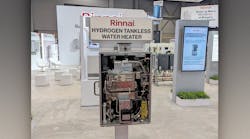In discussing different approaches to decarbonization, sooner or later the potential of hydrogen power will enter the conversation.
Unlike fossil fuels the only end-product from hydrogen combustion is water. Also, hydrogen is attractive to engineers and system designers from an energy-density standpoint. Diesel, for example, has an energy density of 45.5 megajoules per kilogram (MJ/kg), slightly lower than gasoline, which has an energy density of 45.8 MJ/kg. By contrast, hydrogen has an energy density of approximately 120 MJ/kg—almost three times more than diesel or gasoline.
Up until now, the conversation has mostly been around fuel-cell electric vehicles (FCEVs). But recently Rinnai has pioneered hydrogen-powered water heating. The company currently offers models that can burn a 25% hydrogen/75% natural gas blend and has a working 100% hydrogen prototype.
We spoke with Renee Eddy, Rinnai America’s Chief Innovation Officer, about the challenges involved in developing and delivering hydrogen-powered water heating, and its potential both for the industry and consumers around the world.
CONTRACTOR: What do you see as the real promise of hydrogen technology?
Eddy: For the past two years we have been discussing sustainability with our customers. The message has been clear they are looking for balanced solutions. The value of hydrogen technology is providing a viable green gas alternative to our customers. As an example, in Canada and the US today, hydrogen is being blended up to 15% with natural gas. Our customers are aware of this and are looking for assurance’s their appliances will continue to operate as originally specified. Then, as we move towards zero emissions, hydrogen is an option that can help us achieve that goal.
CONTRACTOR: While combusting H2 doesn’t release carbon, it does require energy to produce. Is the value in energy storage? In energy distribution? What do you see as hydrogen’s place in the carbon-reduction toolkit?
Eddy: Thank you for this question, Steve. Hydrogen, just like electricity, requires energy to be produced. Once produced hydrogen can support multiple applications. It can be a direct fuel source for appliances like water heaters or it can be used to replace fossil fuels for certain applications like back up power generation improving efficiency and reducing emissions. The key is to produce hydrogen with green energy. From Rinnai’s perspective, hydrogen is a green fuel source alternative providing customers a viable zero emissions choice.
CONTRACTOR: Tell us about the current offering. Are they all currently available, or are some still in the concept stage?
Eddy: For the blending piece, the majority of our products are developed and produced in Rinnai Japan have already been tested to support Hydrogen blends. As a supplement to that, in the US, we have worked with UL as part of their hydrogen blend verification program and our RE160i and RU199i are the first products in the world to be verified up to 25% hydrogen.
These products exist and are being sold today. Our plan is to continue this verification process across our product lines. Then our 100% hydrogen unit is in the prototype stage. We have prototypes installed in Australia with Australian Gas in their HyHome today and in 2024 we will be installing units in the SoCalGas [H2] Hydrogen Home and ATCO Fort Saskatchewan hydrogen project. We are looking forward to working with SoCalGas and ATCO to build out this important green fuel alternative.
CONTRACTOR: Why was it important for Rinnai to be at the forefront of hydrogen powered water heating?
Eddy: Hydrogen can play a key role in our Rinnai Innovation Manifesto. RIM 2050 has the goal of carbon neutrality/net zero by 2050, and hydrogen is part of our roadmap to achieve this goal. Within Rinnai our evaluations show that 95% of emissions are generated during product utilization. While achieving net zero across Rinnai requires us to address every aspect of our business, we recognize the importance getting product utilization to net zero plays in achieving this goal.
Our customers/end customers (users of our products), installers and builders are starting to ask about this alternative fuel and how our products will react to blends. As the company who has launched the world’s first 100% hydrogen water heater and who have the world’s first product verified up to 25% blending—for these applications Rinnai is the leader in this space.
CONTRACTOR: What are some of the technical challenges in implementing hydrogen powered water heating?
Eddy: Thank you for the question Steve and there are a couple of challenges. From a product perspective we have encountered and worked to overcome several technology challenges with hydrogen. One example is developing the combustion technology for a fuel that for reliable combustion there is the need to develop “combustion stability”.
However, for our appliances the biggest issue we see is the development and build out of a hydrogen infrastructure. Along those lines we are excited to see the Department of Energy (DOE) has put in place the hydrogen hub project and look forward to working with some of the selected teams on this project.
CONTRACTOR: What’s next for Rinnai’s hydrogen-powered offering?
Eddy: For the near term we will be working with UL to verify hydrogen performance across our product line. Then for the longer term launching our 100% hydrogen water heater.


